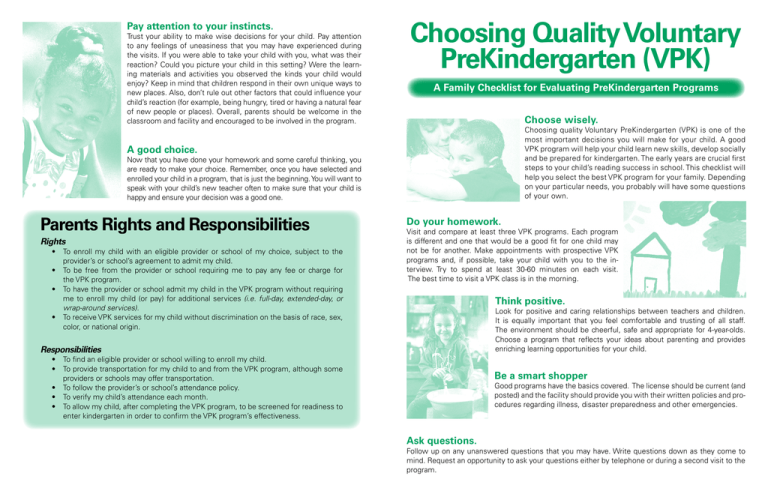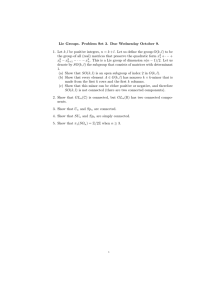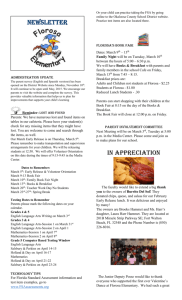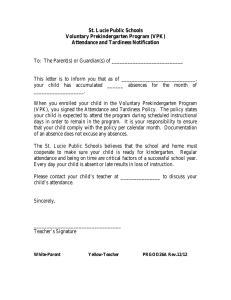Choosing Quality Voluntary PreKindergarten (VPK)
advertisement

Pay attention to your instincts. Trust your ability to make wise decisions for your child. Pay attention to any feelings of uneasiness that you may have experienced during the visits. If you were able to take your child with you, what was their reaction? Could you picture your child in this setting? Were the learning materials and activities you observed the kinds your child would enjoy? Keep in mind that children respond in their own unique ways to new places. Also, don’t rule out other factors that could influence your child’s reaction (for example, being hungry, tired or having a natural fear of new people or places). Overall, parents should be welcome in the classroom and facility and encouraged to be involved in the program. Choosing Quality Voluntary PreKindergarten (VPK) A Family Checklist for Evaluating PreKindergarten Programs Choose wisely. Choosing quality Voluntary PreKindergarten (VPK) is one of the most important decisions you will make for your child. A good VPK program will help your child learn new skills, develop socially and be prepared for kindergarten. The early years are crucial first steps to your child’s reading success in school. This checklist will help you select the best VPK program for your family. Depending on your particular needs, you probably will have some questions of your own. A good choice. Now that you have done your homework and some careful thinking, you are ready to make your choice. Remember, once you have selected and enrolled your child in a program, that is just the beginning. You will want to speak with your child’s new teacher often to make sure that your child is happy and ensure your decision was a good one. Parents Rights and Responsibilities Rights • To enroll my child with an eligible provider or school of my choice, subject to the provider’s or school’s agreement to admit my child. • To be free from the provider or school requiring me to pay any fee or charge for the VPK program. • To have the provider or school admit my child in the VPK program without requiring me to enroll my child (or pay) for additional services (i.e. full-day, extended-day, or wrap-around services). • To receive VPK services for my child without discrimination on the basis of race, sex, color, or national origin. Do your homework. Visit and compare at least three VPK programs. Each program is different and one that would be a good fit for one child may not be for another. Make appointments with prospective VPK programs and, if possible, take your child with you to the interview. Try to spend at least 30-60 minutes on each visit. The best time to visit a VPK class is in the morning. Think positive. Look for positive and caring relationships between teachers and children. It is equally important that you feel comfortable and trusting of all staff. The environment should be cheerful, safe and appropriate for 4-year-olds. Choose a program that reflects your ideas about parenting and provides enriching learning opportunities for your child. Responsibilities • To find an eligible provider or school willing to enroll my child. • To provide transportation for my child to and from the VPK program, although some providers or schools may offer transportation. • To follow the provider’s or school’s attendance policy. • To verify my child’s attendance each month. • To allow my child, after completing the VPK program, to be screened for readiness to enter kindergarten in order to confirm the VPK program’s effectiveness. Be a smart shopper Good programs have the basics covered. The license should be current (and posted) and the facility should provide you with their written policies and procedures regarding illness, disaster preparedness and other emergencies. Ask questions. E Follow up on any unanswered questions that you may have. Write questions down as they come to mind. Request an opportunity to ask your questions either by telephone or during a second visit to the program. What to look for: A Parent’s Checklist Program One ProgramTwo ProgramThree Do the children look happy? Are the children involved in a variety of learning activities? Are there plenty of books and learning materials? Are the children well supervised? Are their individual needs met? Is/Are the teacher(s): Program One ProgramTwo ProgramThree Are there opportunities for language development (teaching new words through play and discovery, reinforcing the sounds of letters, expanding children’s vocabulary through conversation)? Do the children take field trips away from the school site? Where? If applicable, does the program emphasize nutritious food habits and pleasant mealtimes? Kind and encouraging children to explore and work independently or co-operatively in a group? Asking children open ended questions about their work? Listening/talking with individual children? Remaining actively involved throughout the day with the children? Encouraging children to choose some of their own activities? Maintaining control of the class in a positive way? Do the daily activities include: Does the classroom have: What to ask about services, policies and staff: Several different play areas? (including areas for both active play and quiet time). Space for children to move freely? A safe environment that is clean and orderly, with no major repair problems? Child-sized furniture in good condition? Real photographs, current pictures and child’s artwork displayed at child’s level? A place for children to keep their belongings? Is the program licensed? Accredited? What days/hours are available for the VPK program? What are the drop-off and pick-up times and late policies? What is the child-to-teacher ratio? (two teachers per 18 children is the state maximum for VPK) What are the minimum staff credentials for the VPK in this program? (CDA or higher credential required in VPK) How long has the VPK teacher for your child worked there? Are references and background checks conducted on staff? Are staff trained in emergency procedures? Are their CPR and First Aid certification current? Are children encouraged to solve their own problems, through appropriate social skills? Do teachers use non-threatening methods of discipline? Do teachers encourage and model good character and social skills? How are parents informed of illness, injuries, behavior issues, eating, etc.? Is the outdoor playground: Clean, safe and provides enough shade for children? Designed so that a teacher can see all of the children? Large enough for gross motor activities (bikes, balls, climbing, running)? Fenced with no unsafe areas? Organized with an area for children to sit and relax, if needed? Close to a water fountain and rest room? What to ask about the program: Is the curriculum developmentally appropriate? Are the lesson plans posted and do they describe specific daily activities for children? Is there a balance between active and quiet activities? Are there materials available that promote the development of literacy (books, magnetic letters, board games, labels on shelving and toys, etc.)? Opportunities for children to interact in science, math, blocks, dramatic play, art, and music centers? Child participation in large group activities? Small group activities? The opportunity for children to develop self help skills? Outdoor play? Quiet time for rest and relaxation? Organized arrival and departure procedures? Does the provider have written policies/information regarding: (A good program provides this information readily.) Their philosophy about education for young children? How teachers resolve conflicts between children? How teachers discipline children? The education and training of staff?



